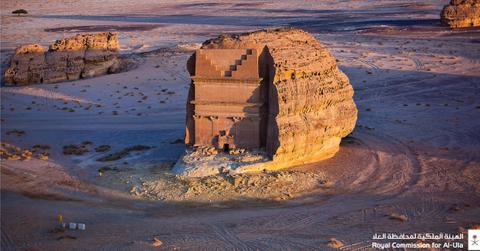Ancient Adventure: Saudi Arabia Opens Access to UNESCO Region Boasting 3,000 Years of Human History

AlUla, a previously inaccessible fascinating historical site over 3,000 years old.
A treasure trove of history spanning over 3,000 years lies nestled within the previously inaccessible beauty of AlUla, also known as al-Ula, in Saudi Arabia.
Hegra, the inaugural UNESCO World Heritage Site in Saudi Arabia, finds its home in this captivating region.
Spanning an impressive 8,711 square miles, AlUla boasts a landscape of lush oasis valleys, majestic sandstone mountains and ancient cultural relics dating back millennia, as highlighted by the Royal Commission for AlUla's official website.
In a landmark move in 2019, the Saudi government opened the gates to this historical haven, granting travel visas for non-religious exploration.
Situated in the Medina province, AlUla served as the cradle for flourishing kingdoms, including the Dadan and Lihyan realms, tracing their origins to 800 and 100 B.C.
Dadan, established around 800 BCE, burgeoned into a bustling trade hub, facilitating the exchange of commodities like frankincense with destinations as far-flung as Egypt, Mesopotamia and the Mediterranean, BBC reported.
Described as one of the most advanced cities of the Arabian Peninsula during the 1st millennium BCE, Dadan remains a testament to ancient ingenuity and prosperity, according to the Royal Commission for AlUla.
Hegra, an ancient city etched into history as Saudi Arabia's premier UNESCO World Heritage Site, stands as a testament to the Nabataean Kingdom's grandeur.
- What Lies Beneath: NASA Scientist Believes Aliens May Have Found 'Perfect' Hiding Spot in Earth's Oceans
- Global Threat: Russia Insider Warns West of 'World War Using Nuclear Weapons' Amid Escalating Support for Ukraine
- Countdown to Disaster? Ex-NATO Official Warns Russia, Iran and China Could Wage WWIII in Just Years
Comprising nearly 100 impeccably preserved tombs, Hegra's intricate sandstone facades beckon visitors to marvel at their timeless beauty. Recent research suggests that Hegra served as a southern bastion for the Romans following their conquest of the Nabataeans in 106 CE.
Originating from southern Jordan, the Nabataean civilization flourished, extending its influence to northwest Arabia by the 1st century B.C., as reported by BBC.
Within Hegra's sprawling archaeological complex lie 111 tombs, including the awe-inspiring Qasr al-Farid, a testament to Nabataean craftsmanship and heritage.
Never miss a story — sign up for the Front Page Detectives newsletter. Be on the scene the moment news breaks.
Adding to AlUla's allure is Elephant Rock, or Jabal AlFil, a colossal geological formation sculpted over eons by the relentless forces of wind and water. As dusk descends, the rock takes on an enchanting hue, casting a mesmerizing crimson glow over AlUla's famed natural marvel.
The unlocking of AlUla's secrets to the wider world has sparked a wave of groundbreaking discoveries. Since 2019, a dedicated team of researchers has embarked on the first comprehensive archaeological survey of the region, reshaping our understanding of its rich history.
Dr. Rebecca Foote, Director of Archaeology and Cultural Heritage Research for the Royal Commission for AlUla, emphasizes the dynamic nature of AlUla's ancient settlements, shedding new light on the vibrant tapestry of its past, as reported by BBC.
Become a Front Page Detective
Sign up to receive breaking
Front Page Detectives
news and exclusive investigations.
